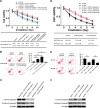LINC01224/ZNF91 Promote Stem Cell-Like Properties and Drive Radioresistance in Non-Small Cell Lung Cancer
- PMID: 34285587
- PMCID: PMC8286114
- DOI: 10.2147/CMAR.S313744
LINC01224/ZNF91 Promote Stem Cell-Like Properties and Drive Radioresistance in Non-Small Cell Lung Cancer
Abstract
Background: Radioresistance is the main reason for the failure of radiotherapy in non-small-cell lung cancer (NSCLC); however, the molecular mechanism of radioresistance is still unclear.
Methods: An RNA-Seq assay was used to screen differentially expressed long non-coding RNAs (lncRNAs) and genes in irradiation-resistant NSCLC cells. RT-PCR and Western blotting assays were performed to analyze the expressions of lncRNAs and genes. The chromosome conformation capture (3C) assay was performed to measure chromatin interactions. Cell cytotoxicity, cell apoptosis, sphere formation and Transwell assays were performed to assess cellular function.
Results: In this study, it was found that LINC01224 increased during the induction of radioresistance in NSCLC cells. LINC01224 was located within the enhancer of ZNF91, and LINC01224 could affect the transcription of ZNF91 by regulating the long-range interactions between the ZNF91 enhancer and promoter. Moreover, upregulation of LINC01224 and ZNF91 could promote irradiation resistance by regulating the stem cell-like properties of NSCLC cells. In addition, high expression levels of LINC01224 and ZNF91 in tissue samples were associated with radioresistance in NSCLC patients.
Conclusion: Our findings demonstrated that LINC01224/ZNF91 drove radioresistance regulation by promoting the stem cell-like properties in NSCLC.
Keywords: LINC01224; ZNF91; non-small cell lung cancer; radioresistance; stem cell-like properties.
© 2021 Fu et al.
Conflict of interest statement
The authors declare that they have no competing interests.
Figures





Similar articles
-
Long non‑coding RNA LINC01224 promotes cell proliferation and inhibits apoptosis by regulating AKT3 expression via targeting miR‑485‑5p in endometrial carcinoma.Oncol Rep. 2021 Sep;46(3):186. doi: 10.3892/or.2021.8137. Epub 2021 Jul 19. Oncol Rep. 2021. PMID: 34278482 Free PMC article.
-
LINC01224 Exhibits Cancer-Promoting Activity in Epithelial Ovarian Cancer Through microRNA-485-5p-Mediated PAK4 Upregulation.Onco Targets Ther. 2020 Jun 16;13:5643-5655. doi: 10.2147/OTT.S254662. eCollection 2020. Onco Targets Ther. 2020. Retraction in: Onco Targets Ther. 2021 Sep 30;14:4939-4940. doi: 10.2147/OTT.S341523. PMID: 32606778 Free PMC article. Retracted.
-
CLPTM1L induces estrogen receptor β signaling-mediated radioresistance in non-small cell lung cancer cells.Cell Commun Signal. 2020 Sep 17;18(1):152. doi: 10.1186/s12964-020-00571-4. Cell Commun Signal. 2020. PMID: 32943060 Free PMC article.
-
LINC01224 Promotes Colorectal Cancer Progression by Sponging miR-2467.Cancer Manag Res. 2021 Jan 26;13:733-742. doi: 10.2147/CMAR.S281625. eCollection 2021. Cancer Manag Res. 2021. PMID: 33542656 Free PMC article.
-
Long non-coding RNAs: How to regulate the metastasis of non-small-cell lung cancer.J Cell Mol Med. 2020 Mar;24(6):3282-3291. doi: 10.1111/jcmm.15054. Epub 2020 Feb 12. J Cell Mol Med. 2020. PMID: 32048814 Free PMC article. Review.
Cited by
-
Comprehensive analysis of basement membrane and immune checkpoint related lncRNA and its prognostic value in hepatocellular carcinoma via machine learning.Heliyon. 2023 Sep 27;9(10):e20462. doi: 10.1016/j.heliyon.2023.e20462. eCollection 2023 Oct. Heliyon. 2023. PMID: 37810862 Free PMC article.
-
Review: Mechanisms and perspective treatment of radioresistance in non-small cell lung cancer.Front Immunol. 2023 Feb 14;14:1133899. doi: 10.3389/fimmu.2023.1133899. eCollection 2023. Front Immunol. 2023. PMID: 36865554 Free PMC article. Review.
-
Tumor-suppressive E3 ubiquitin ligase CHIP inhibits the PBK/ERK axis to repress stem cell properties and radioresistance in non-small cell lung cancer.Apoptosis. 2023 Apr;28(3-4):397-413. doi: 10.1007/s10495-022-01789-y. Epub 2022 Nov 27. Apoptosis. 2023. PMID: 36436119
-
Long Non-Coding RNAs in Lung Cancer: The Role in Tumor Microenvironment.Front Cell Dev Biol. 2022 Jan 3;9:795874. doi: 10.3389/fcell.2021.795874. eCollection 2021. Front Cell Dev Biol. 2022. PMID: 35047506 Free PMC article. Review.
-
Identification and Characterization of an Ageing-Associated 13-lncRNA Signature That Predicts Prognosis and Immunotherapy in Hepatocellular Carcinoma.J Oncol. 2023 Feb 17;2023:4615297. doi: 10.1155/2023/4615297. eCollection 2023. J Oncol. 2023. PMID: 36844873 Free PMC article.
References
-
- Rotow J, Bivona TG. Understanding and targeting resistance mechanisms in NSCLC. Nat Rev Cancer. 2017;17:637–658. - PubMed
LinkOut - more resources
Full Text Sources

